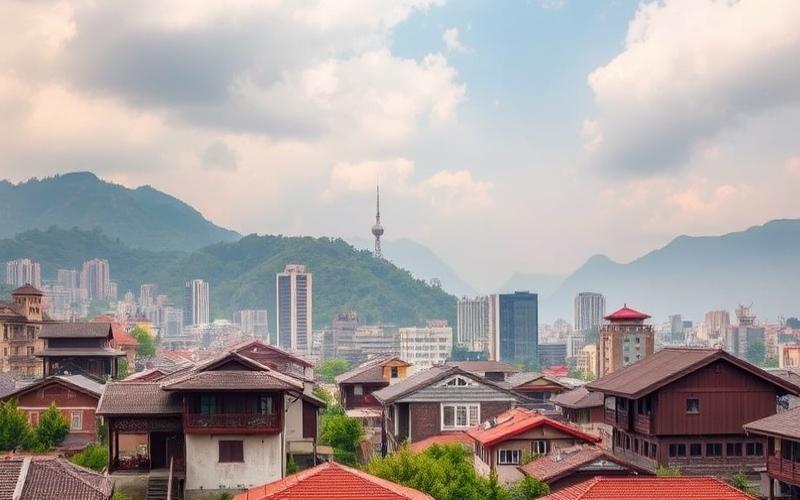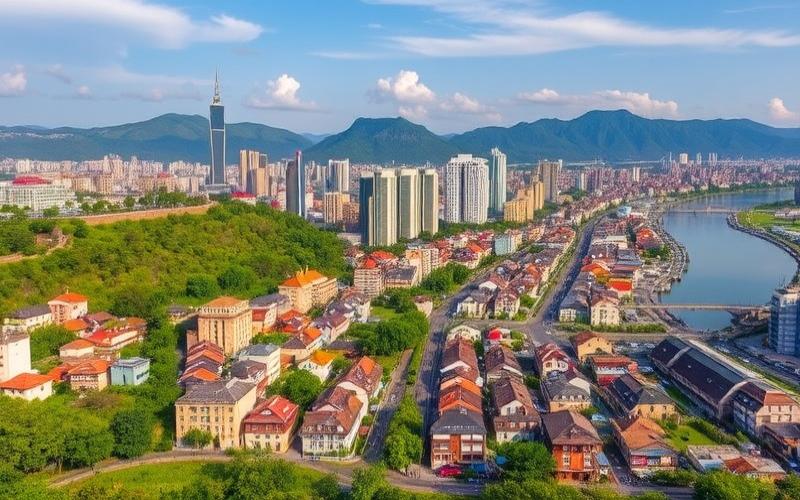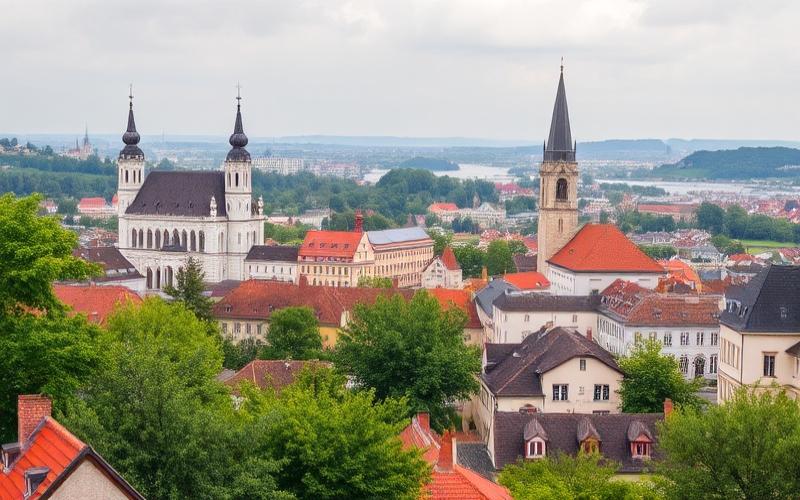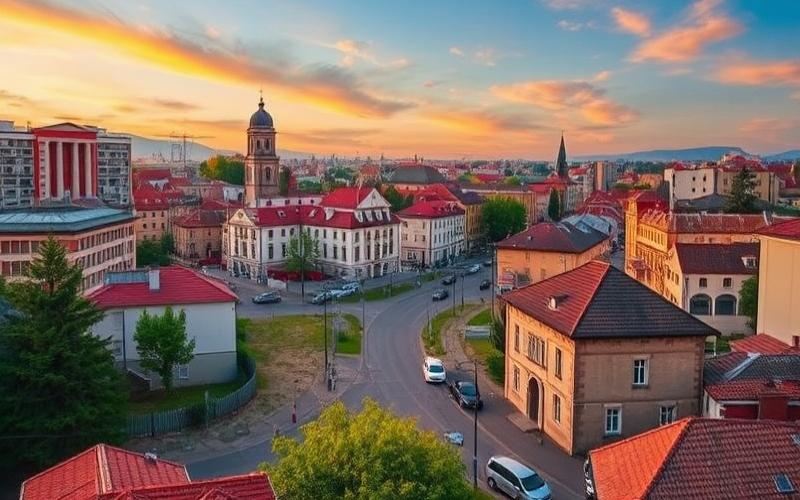
 Published on and written by Cyril Jarnias
Published on and written by Cyril Jarnias
At a time when the global real estate market continues to cause concern, Hungary stands out with an innovative trend: micro-apartments. These compact homes, optimized to provide maximum comfort in minimal space, meet a growing demand for affordable solutions for young professionals and students facing exorbitant prices in major cities.
By combining functionality and economy, Hungarian micro-apartments are establishing themselves not only as a smart financial choice but also as a promising environmental solution, emphasizing space optimization without compromising quality of life.
Exploring Hungary’s Micro-Apartment Market
Current Trends in Hungary’s Micro-Apartment Market
Demand for micro-apartments is experiencing significant growth, driven by rapid urbanization, the search for affordable housing, and changing preferences among young professionals and students. Micro-housing is particularly popular in major cities like Budapest, where real estate pressure is high.
Key Economic and Social Factors:
- Increasing urbanization: The influx into urban centers stimulates the need for compact housing.
- Financial accessibility: With continuously rising real estate prices in central neighborhoods, many are turning to smaller spaces to stay close to downtown while managing their budget.
- New generational expectations: Young professionals prioritize proximity to their workplace or studies and seek flexibility along with reduced total costs (rent + utilities).
- Recent incentive policies: Attractive interest rate loans for first-time buyers, maintenance of a reduced VAT rate (5%) on new residential properties, specific tax exemptions.
Comparison of Average Prices per Square Meter (2025):
| Area / City | Micro-apartment (€/m²) | Standard Apartment (€/m²) |
|---|---|---|
| Budapest V & XII | 3,170 | 2,800 – 3,000 |
| Újbuda | ~2,600 | ~2,200 |
| Soroksár | 1,390 | ~1,200 |
| Major Regional Cities* | ~1,100 | ~900 |
Investing in Studios: A Secure Choice
Investing in studios in Hungary is considered a secure choice thanks to a combination of favorable economic, demographic, and tax factors, as well as attractive profitability prospects in the current real estate market.
Economic and Demographic Factors Supporting Micro-Apartment Demand:
- Continued urban growth: Major Hungarian cities, particularly Budapest, Debrecen, and Szeged, are experiencing a steady increase in their urban population. This dynamic is driven by the influx of students, young professionals, and expatriates seeking compact housing near activity centers.
- Trend toward reduced living space: The societal shift toward smaller households (singles or couples without children) fuels demand for studios and micro-apartments that offer flexibility and practicality.
- Increased search for affordable solutions: Faced with the general rise in housing costs in Central Europe, micro-housing represents an economically accessible solution for many. For example:
| Type | Area | Average Purchase Price (Budapest) | Potential Monthly Rent | Gross Annual Yield |
|---|---|---|---|---|
| 5th District Studio | 35 m² | 50 M HUF (~€122,000) | 300,000 HUF (~€730) | 7–9% |
| Central Studio (other districts) | ~30–40 m² | ~€120,000–150,000 | ~€430–530 | 5–6% |
Rents increased between +5% and +8% between 2024 and mid-2025 in central neighborhoods, a sign of strong rental pressure fueled by the regular arrival of international students and young professionals.
Tax Benefits for Real Estate Investors:
- Attractive taxation on rental income, with a flat rate set at 15%. There is no progressive taxation or major additional social contributions on this income.
- Moderate property tax, generally between €150 and €350/year depending on the property size.
These stable tax conditions favor accurate calculation of expected net returns.
Concrete Rental Profitability Prospects:
- Average gross yield for a well-located studio in Budapest or Debrecen: generally between 5% and over 7%, especially in short-term rentals in tourist areas.
- Net after expenses (including taxes): typically around 3.5% – 4.2%, after deducting rental tax, professional management (~10–15%), maintenance (~5–10%) — which remains competitive compared to other European capitals where taxation can be significantly less favorable.
Concrete example:
A studio purchased for approximately €122,000 in the city center can generate up to €730/month in short-term rental with an occupancy rate close to 70%, representing nearly 7‑9% gross/year.
Current Trends Enhancing Sector Attractiveness:
- Strong post-pandemic stability with rapid recovery of the urban tourism market
- Constant development of university infrastructure strengthening student flow
- Regular but moderate increase in square meter prices (+170% since 2015 according to OECD), demonstrating healthy growth without excessive speculative bubble
In summary, investing in a studio in Hungary combines relative security (strong structural demand), light taxation suitable for foreign and local investors, interesting gross yields that can exceed those observed in several neighboring countries — especially in a European context where access to affordable housing is becoming scarce.
Good to Know:
Investing in studios in Hungary is a secure option, largely due to the continuous growth of the urban population and increased demand for affordable, compact housing, a phenomenon amplified by the trend toward reduced living space. In 2022, demand for micro-apartments surged by 15%, driven by an influx of students and young professionals attracted by more moderate rents than in other European countries. Additionally, Hungarian legislation offers attractive tax benefits, such as reduced taxation on rental income, boosting profitability with average rental yields reaching up to 7%. Recent statistics indicate an average value of €3,000 per square meter, recording a 5% increase over one year, confirming stable market appreciation. Investors also benefit from the country’s economic stability, with inflation controlled at 6% in 2023, providing a reassuring framework for long-term investment.
Microliving: Growing Trend for Affordable Housing
The rise of microliving in Hungary is establishing itself as an attractive and affordable solution for residents seeking access to low-cost housing in a context of increasing economic pressures and soaring real estate prices.
Factors Explaining the Rise of Microliving:
- Economic pressures: The continuous rise in real estate prices (+12.5% year-over-year in Q1 2025, including +5.7% for existing properties and +2.3% for new builds) restricts access to homeownership, especially for first-time buyers and young professionals.
- Rising rents: Rents increased by 7% nationally over one year, reaching an average of 260,000 HUF in Budapest in June 2025, and 230,000 HUF in Debrecen, with rents between 160,000 and 190,000 HUF in other major cities.
- Decrease in new housing supply: In 2024, the number of homes delivered fell by 29% compared to the previous year, increasing pressure on the rental market.
- Demographic changes: Urbanization, increased mobility of young professionals, aging population, and rising number of international students fuel demand for compact, well-located, and affordable housing.
Statistics Illustrating the Hungarian Real Estate Market in 2025:
| Indicator | Value (2025) |
|---|---|
| Real Estate Prices (annual increase) | +12.5% |
| Rent Increase (national) | +7% |
| Average Rent Budapest (June) | 260,000 HUF/month |
| Average Rent Debrecen | 230,000 HUF/month |
| New Homes Delivered (2024) | 13,295 (-29% vs 2023) |
| Homes Built H1 2025 | 5,129 (-15% vs 2024) |
Examples of Micro-Apartment Projects in Hungary:
- Budapest 9th District: A micro-apartment project (18-25 m²) aimed at students and young professionals shows an occupancy rate of over 95%, with competitive rents and shared services (laundry, coworking spaces, shared kitchens).
- Corvin Quarter: Several recent buildings offer optimized studios (20-30 m²) equipped with multifunctional furniture, targeting young professionals working downtown.
- Senior Projects: Residences integrating micro-units adapted for urban retirees offer security, proximity to services, and controlled costs.
Benefits of Microliving for Different Audiences:
- Young Professionals: Access to independent housing in city centers despite soaring prices, flexible contracts, proximity to employment hubs and infrastructure.
- Students: More affordable rents than traditional apartments, shared spaces promoting social life, adaptation to temporary stays or mobility.
- Retirees: Opportunity to downsize without sacrificing location, increased security, and easier access to urban services.
Practical and Economic Aspects:
- Space optimization (retractable furniture, built-in storage)
- Reduced expenses (energy, maintenance, taxes)
- Shared common spaces (kitchen, laundry, gym)
Challenges of Microliving:
- Space optimization without compromising comfort: need for innovative architectural design and multifunctional furniture to avoid a cramped feeling.
- Maintaining quality of life: ensuring good sound insulation, effective ventilation, access to natural light, and welcoming common areas.
- Social acceptability: combating the stigma of small housing and considering the diverse needs of residents.
*********************************
Microliving thus asserts itself as a pragmatic response to the housing crisis in Hungary, reconciling economic accessibility, strategic location, and adaptation to societal changes.
Good to Know:
Microliving is emerging as an affordable solution amid growing economic pressures in Hungary, where rising real estate prices make access to traditional housing difficult for many residents. In 2023, the average price per square meter in Budapest exceeded €1,000, pushing more and more young professionals, students, and retirees toward micro-apartments. These compact spaces optimize every centimeter to provide a functional living environment without major compromises on comfort, as demonstrated by recent projects in Budapest and Debrecen where entire communities are being built around microliving. However, the challenge lies in balancing space profitability and quality of life, with developers constantly seeking to innovate in design and layout to maximize the efficiency of living spaces.
Small Space Returns: Toward New Perspectives
Economic Benefits of Micro-Apartments for Low-Budget Households
- Micro-apartments offer an affordable solution in the face of rising real estate prices, particularly in Budapest where demand remains high.
- The acquisition or rental cost per square meter is competitive for areas between 15 and 30 m², allowing low-income households to access ownership or rental in city centers.
- Expenses (heating, electricity, maintenance) are reduced due to the small size, easing the monthly budget.
- Investors are very active in this segment, representing 62% of buyers, indicating high liquidity and attractive returns for resale or rental.
- The sales period for micro-apartments is significantly shorter than for larger homes, promoting financial flexibility.
Layout Optimization: Comfort and Energy Efficiency
- Smart layout maximizes the use of every square meter through:
- Multifunctional furniture (retractable beds, folding tables)
- Built-in storage high up or under stairs
- Removable or translucent partitions to create flexible spaces
- Enhanced insulation and reduced volumes to heat allow for superior energy efficiency compared to larger homes.
- Ventilation systems, LED lighting, and compact, low-consumption appliances help reduce energy costs.
Architectural and Design Innovations in Hungary
| Innovation | Description | Example in Budapest |
|---|---|---|
| Space Conversion | Conversion of offices or former workshops into modern micro-homes | Districts VI and VII |
| Custom Furniture | Design of integrated furniture to optimize every nook | Projects in the 6th District |
| Shared Spaces | Development of residences with shared kitchen, laundry, or coworking areas | Renovated buildings downtown |
| Minimalist Design | Use of light colors, mirrors, and large windows to visually enlarge | New projects in the XIIIth |
Social and Economic Impacts on Residents and Neighborhoods
- Increased accessibility for students, young professionals, singles, or couples without children, who find an alternative to traditional housing.
- Urban revitalization: the presence of new residents supports local businesses, promotes social mix, and revitalizes some central neighborhoods.
- Risk of gentrification in some districts where the rise of micro-apartments attracts investors at the expense of lower-income households.
- Strengthened community life in residences offering common areas, fostering mutual aid and social integration.
Public Policies and Incentives in Hungary
- Existence of tax measures and subsidies favoring the purchase of real estate, including micro-apartments, especially for first-time buyers or young families.
- Possible use of voluntary retirement savings for property purchase, increasing financial accessibility for households.
- Public authorities encourage renovation of the existing housing stock to meet growing demand for affordable housing, although specific legislation for micro-apartments is still under development.
Micro-apartments thus represent an economic, ecological, and urban response to housing challenges in Hungary, particularly in major cities like Budapest.
Good to Know:
Micro-apartments in Hungary offer an economical solution for those seeking affordable housing and help reduce living costs through decreased energy consumption due to space optimization. Innovations such as modular furniture and movable walls, as in the ‘Hello Wood’ project, exemplify efficient architecture, maximizing comfort and functionality. The social impact is notable, as these spaces promote urban integration and revitalize neighborhoods through increased demographic diversity. Economically, they attract real estate investors interested in the profitability of small units. The Hungarian government encourages this market through tax incentives and subsidies directed toward the renovation and construction of compact housing, thus facilitating access for young people and low-income earners.
Disclaimer: The information provided on this website is for informational purposes only and does not constitute financial, legal, or professional advice. We encourage you to consult qualified experts before making any investment, real estate, or expatriation decisions. Although we strive to maintain up-to-date and accurate information, we do not guarantee the completeness, accuracy, or timeliness of the proposed content. As investment and expatriation involve risks, we disclaim any liability for potential losses or damages arising from the use of this site. Your use of this site confirms your acceptance of these terms and your understanding of the associated risks.


















































